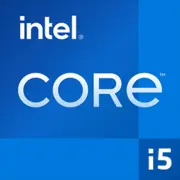Intel Core i5-4440S

Intel Core i5-4440S: Review and Relevance in 2025
Haswell architecture, energy efficiency, and use cases
Key Specifications: What the i5-4440S Offers
The Intel Core i5-4440S processor, released in 2013, is still found in budget PCs and upgrade systems. Let's examine its key parameters:
- Architecture: Haswell (4th generation Intel Core).
- Process Technology: 22 nm — a progressive standard for its time but now outdated (modern CPUs use 5–7 nm).
- Cores and Threads: 4 cores, 4 threads — the lack of Hyper-Threading limits multitasking.
- Frequency: Base — 2.8 GHz, maximum in turbo mode — 3.3 GHz.
- Cache: L3 — 6 MB, which is sufficient for basic tasks but limited for heavy applications.
- TDP: 65 W — low power consumption for a desktop CPU.
- Graphics: Intel HD 4600 — supports 4K via DisplayPort but is weak for gaming (e.g., CS:GO on low settings — 40–50 FPS).
- Performance: Geekbench 6 — 808 (Single-Core), 2040 (Multi-Core). For comparison, the modern Ryzen 5 5500 scores around ~1500/4500.
Key Features:
- Energy efficiency — suitable for compact builds.
- Support for AVX2 instructions — accelerates media processing.
- Integrated graphics — allows for a PC to be built without a discrete graphics card.
Compatible Motherboards: What to Choose in 2025
The processor uses the LGA 1150 socket, which is no longer supported by new motherboards. Current chipsets:
- H81/B85: Budget options with basic features (USB 3.0, SATA III). Example: ASUS H81M-K ($50–70 in 2025).
- H87/H97: Enhanced capabilities — RAID support, more SATA ports.
- Z87/Z97: For enthusiasts — overclocking (though the i5-4440S has a locked multiplier).
Choosing Considerations:
- New LGA 1150 motherboards are rarely produced, so look for them on the secondary market.
- Check the condition of VRM modules — old boards often suffer from bulging capacitors.
- Update BIOS to the latest version for compatibility with Windows 11 (requires UEFI and Secure Boot).
Supported Memory: DDR3 and Its Limitations
The i5-4440S only works with DDR3-1600 MHz (maximum of 32 GB in dual-channel mode).
Recommendations:
- Use two 8 GB modules to activate dual-channel mode (e.g., Kingston HyperX Fury DDR3-1600).
- Avoid memory with high latency (CL9–11 is optimal).
- DDR4/DDR5 are not supported — this is a major limitation for upgrades.
Power Supply: Power Calculation
With a TDP of 65 W, the processor does not require a powerful PSU, but it's important to consider other components:
- Without a discrete graphics card: A 300 W PSU is sufficient (e.g., be quiet! SFX Power 3 300W, $45).
- With a graphics card like NVIDIA GTX 1650: A 400–450 W PSU is recommended (Corsair CX450M, $55).
- Tips:
- Choose units with an 80+ Bronze certificate or higher.
- Avoid cheap no-name models — unstable voltage can damage components.
Pros and Cons of the i5-4440S
Advantages:
- Low power consumption — ideal for office PCs and media centers.
- Reliability — a tried and true architecture.
- Affordable price on the secondary market ($30–50 in 2025).
Disadvantages:
- No support for DDR4/PCIe 4.0 — limits upgrades.
- Weak performance in modern games and applications (e.g., Blender or Premiere Pro).
- Lack of Hyper-Threading — falls short in multi-threaded tasks.
Use Cases: Where the CPU is Still Relevant
1. Office Tasks: Document work, browsing, Zoom — the processor handles it without lag.
2. Multimedia: Watching 4K videos (thanks to HD 4600), music streaming.
3. Casual Gaming: Dota 2, Minecraft, indie projects (at medium settings).
4. Home Server: Low TDP allows for energy savings.
Practical Example:
A user built a PC using the i5-4440S and GTX 1050 Ti for their child — the system runs Fortnite at 60 FPS (on Low settings).
Comparison with Competitors
- AMD FX-8350: 8 cores, but weak Single-Core performance (~600 in Geekbench 6). Better for rendering but worse for gaming.
- Intel Core i3-10100: 4 cores/8 threads, Geekbench 6 — 1200/3800. Newer architecture but requires a motherboard replacement.
- Ryzen 3 3200G: Integrated Vega 8 graphics stronger than HD 4600, but more expensive ($90–100).
Conclusion: The i5-4440S falls behind modern counterparts but remains attractive on a tight budget.
PC Building Tips for the i5-4440S
1. Motherboard: Look for models with USB 3.1 and M.2 (e.g., ASRock H97M Pro4 — M.2 slot via adapter).
2. Cooling: The stock cooler is sufficient, but for quiet operation, consider the DeepCool GAMMAXX 400 ($20).
3. Storage: Use an SSD (Samsung 870 EVO 500 GB, $45) to speed up the system.
4. Upgrade: Add a graphics card such as GTX 1660 Super — this is the maximum balance with the CPU.
Final Conclusion: Who Is the i5-4440S Suitable For?
This processor is worth considering in three cases:
1. Budget Builds: When you need to assemble a PC for $150–200 (considering used components).
2. Upgrading an Old Computer: Replacing an outdated Pentium or Core i3 in an LGA 1150 setup.
3. Energy-Efficient Systems: Media centers, office PCs, home servers.
Why Is It Still Relevant in 2025?
Despite its age, the i5-4440S remains a reliable solution for undemanding tasks. Its key advantages are its price and minimal power consumption. However, for gaming, video editing, or AI work, a more modern CPU should be chosen.
The article is current as of April 2025. Prices are indicated for new components if available on the market.
Basic
CPU Specifications
Memory Specifications
GPU Specifications
Benchmarks
Compared to Other CPU
Share in social media
Or Link To Us
<a href="https://cputronic.com/cpu/intel-core-i5-4440s" target="_blank">Intel Core i5-4440S</a>